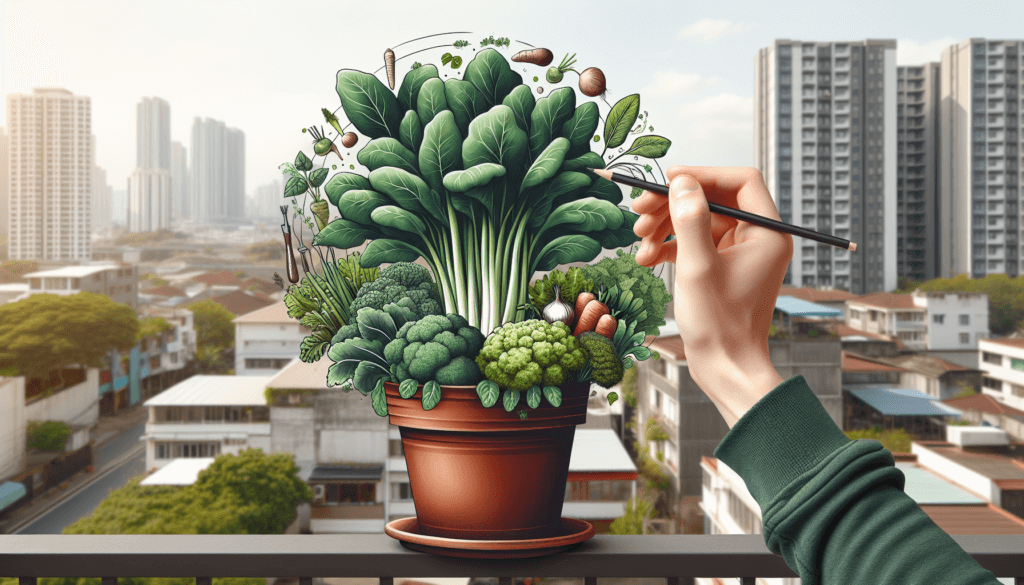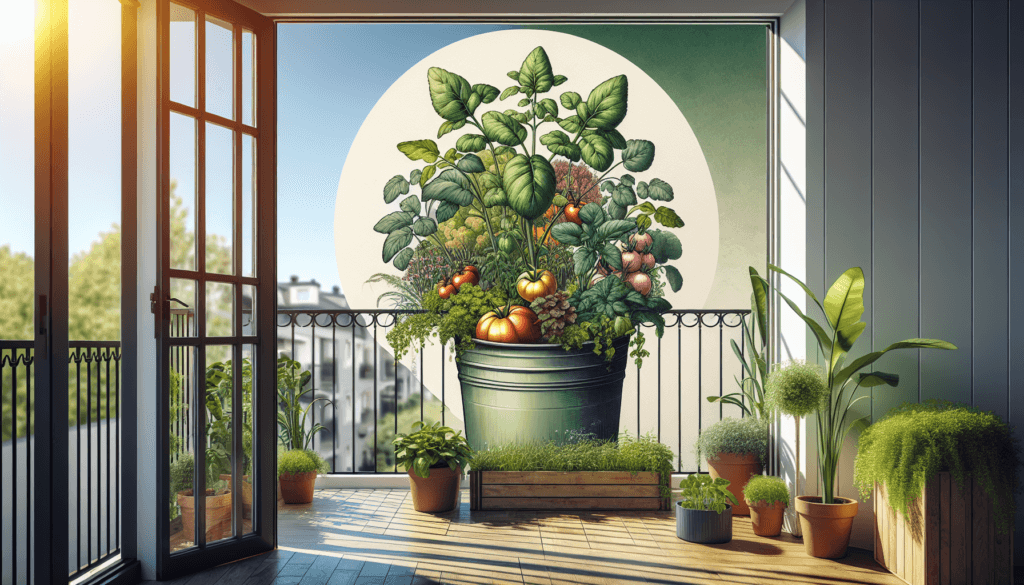Imagine stepping out onto your balcony and being greeted by a lush and vibrant vegetable garden. With just a few simple steps, you can transform your small outdoor space into a thriving oasis of fresh produce. In this article, we will guide you through the process of creating your very own balcony vegetable garden, from choosing the right plants to maximizing your limited space. Get ready to cultivate your green thumb and enjoy the taste of homegrown goodness, all from the comfort of your own balcony.

Choosing the Right Plants
Consider the Balcony’s Sun Exposure
When choosing plants for your balcony garden, it’s important to consider the amount of sun exposure your balcony receives. Some plants thrive in full sun, while others prefer partial shade. Observe your balcony throughout the day to determine the sunniest and shadiest spots. This will help you select the right plants that will thrive in your balcony’s specific lighting conditions.
Research the Climate and Growing Season
Understanding your local climate and growing season is essential for successful balcony gardening. Certain plants have specific temperature and climate requirements for optimal growth. Research your region’s average temperatures, frost dates, and any microclimates that may exist on your balcony. This information will guide you in selecting plants that are suitable for your area and will ensure a bountiful harvest.
Select Plants that Thrive in Containers
Since you’ll be growing your vegetable garden in containers on your balcony, it’s crucial to choose plants that are well-suited for container gardening. Look for varieties that have been bred specifically for container growth, as these plants typically have compact habits and require less space to flourish. Vegetables like cherry tomatoes, peppers, and salad greens are excellent choices for container gardening.
Consider the Available Space
Before you start planting, carefully assess the available space on your balcony. Determine the size and shape of your containers, as well as the amount of space you have for each plant. Take into account the growth habits of the plants you’ve selected and ensure they will have enough room to spread their roots and foliage. Utilize vertical space by incorporating trellises or hanging baskets to maximize your growing area.
Preparing the Balcony
Evaluate the Balcony’s Weight-Bearing Capacity
Before transforming your balcony into a vegetable garden, it’s important to evaluate its weight-bearing capacity. The combined weight of containers, soil, plants, and watering can be substantial, so make sure your balcony can safely support the added load. Consult a professional if you’re unsure about the structural integrity of your balcony.
Check for Proper Drainage
Proper drainage is crucial for the health of your balcony garden. Ensure that your containers have drainage holes to prevent waterlogging, which can lead to root rot and other plant diseases. Place saucers or trays underneath the containers to catch excess water and prevent it from staining or damaging your balcony surface.
Clean and Prep the Balcony Surface
Start with a clean slate by thoroughly cleaning your balcony surface. Sweep away any debris, dust, or dirt. If needed, use a mild detergent and warm water to scrub away any stains or grime. Rinse the surface well and allow it to dry completely before setting up your containers and starting your garden.
Set Up Protective Barriers
If you live in an urban environment, it’s essential to protect your balcony garden from strong winds, curious animals, and prying eyes. Install windbreakers or privacy screens to shield your plants from excessive wind. Consider adding netting or wire mesh to prevent pests from damaging your plants. These protective barriers will ensure the safety and privacy of your balcony garden.
Selecting Containers and Soil
Choose the Right Containers for Your Plants
Selecting the right containers for your plants is crucial for their overall health and productivity. Look for containers that have adequate drainage holes and are the appropriate size for your plants’ root systems. Consider the material the containers are made of, such as clay, plastic, or fabric, as each material has its own advantages and considerations.
Select High-Quality Potting Soil or Mix
Investing in high-quality potting soil or mix is essential for providing the necessary nutrients and proper drainage for your plants. Look for a mix that is specifically formulated for container gardening and contains organic matter, such as compost or peat moss. Avoid using garden soil, as it tends to be too heavy and may not drain well in containers.
Consider Self-Watering Containers
If you’re concerned about watering your plants regularly, consider using self-watering containers. These containers have a reservoir at the bottom that allows plants to draw water as needed, reducing the frequency of watering. Self-watering containers are especially beneficial if you have a busy schedule or are new to gardening.
Ensure Proper Drainage
Proper drainage is crucial for container gardening success. Ensure that your containers have ample drainage holes to allow excess water to escape. Elevate your containers using pot feet or bricks to further improve drainage. This will prevent waterlogged roots and promote healthy plant growth.
Sourcing and Starting Seeds
Decide Between Seeds and Seedlings
Deciding whether to start your balcony garden with seeds or seedlings is a personal preference. Starting from seeds allows you to have a wider variety of plant choices and a sense of satisfaction from watching your plants grow from scratch. However, seedlings provide a head start and ensure a more predictable outcome. Consider your experience level, time availability, and preferences when making this decision.
Choose Heirloom or Hybrid Seeds
When sourcing seeds for your balcony garden, you’ll come across heirloom and hybrid varieties. Heirloom seeds are open-pollinated and have been passed down for generations, preserving their unique characteristics. Hybrid seeds, on the other hand, are cross-pollinated to produce specific traits, such as disease resistance or higher yields. Decide whether you prefer the history and diversity of heirloom seeds or the predictability and uniformity of hybrid seeds.
Source Seeds from Reliable Suppliers
To ensure the quality and reliability of your seeds, source them from reputable suppliers. Look for suppliers that specialize in organic or heirloom seeds and have good customer reviews. Online seed stores and local nurseries are excellent places to find a wide variety of high-quality seeds. Remember to check the seed packets for specific planting instructions and recommendations.
Start Seeds Indoors or Directly on the Balcony
Depending on your climate and the specific plant requirements, you can start seeds indoors or directly on your balcony. Starting seeds indoors allows for better control over temperature and moisture, and it extends the growing season. However, some vegetables, like carrots or beans, prefer to be directly sown into the containers. Be mindful of the individual needs of your plant selections and follow the recommended planting instructions.

Planting and Transplanting
Follow Planting Instructions and Spacing Guidelines
Each plant has specific planting instructions and spacing requirements. Refer to the seed packets or plant labels for guidance on the ideal planting depth, spacing between plants, and distance between rows. Following these instructions will promote healthy plant growth, prevent overcrowding, and optimize your balcony garden’s productivity.
Transplant Seedlings Carefully
If you choose to start with seedlings, it’s important to transplant them carefully into your containers. Gently remove the seedlings from their starter pots, being careful not to damage their delicate roots. Create a hole in the potting mix in the container, place the seedling in the hole, and gently firm the soil around the base of the plant. Water the seedlings thoroughly after transplanting to help them settle into their new homes.
Provide Adequate Support for Climbing Plants
If you’re planning to grow climbing plants, such as cucumbers or beans, it’s crucial to provide them with adequate support. Install trellises, stakes, or cages in your containers to guide the plants’ growth upwards. This will save space, improve air circulation, and prevent the plants’ foliage and fruits from sprawling all over your balcony.
Consider Companion Planting
Companion planting is a gardening technique that involves planting certain crops together to enhance their growth and repel pests. Consider incorporating companion plants in your balcony garden to maximize its productivity and minimize pest issues. For example, planting marigolds near tomatoes can deter pests like aphids and nematodes, while providing shade and support.
Watering and Fertilizing
Determine a Watering Schedule and Method
Establishing a regular watering schedule is essential for the health and productivity of your balcony garden. Observe your plants and assess their water needs based on factors such as the weather, soil moisture, and plant size. Water your plants thoroughly, allowing the water to penetrate the root zone. Consider using a watering can, hose with a gentle spray nozzle, or a drip irrigation system to ensure even and efficient watering.
Check Soil Moisture Regularly
Monitor the moisture level of the soil in your containers regularly. Stick your finger into the soil up to the second knuckle to check if it’s moist or dry. If the soil feels dry, it’s time to water your plants. Be mindful of overwatering, as it can lead to root rot and other fungal diseases. Finding the right balance in watering will promote healthy plant growth.
Use Organic Fertilizers or Compost Tea
To ensure your plants receive the necessary nutrients, consider using organic fertilizers or compost tea. Organic fertilizers, such as compost or well-rotted manure, provide slow-release nutrients that promote long-term soil health. Compost tea, made by steeping compost in water, is a nutrient-rich liquid fertilizer that can be applied directly to the plants. These organic options are environmentally friendly and safe for both you and your plants.
Avoid Overwatering
Overwatering is a common mistake in balcony gardening. It can lead to root rot, mold growth, and the death of your plants. To avoid overwatering, ensure that your containers have proper drainage and that you’re not watering too frequently. Allow the top inch of soil to dry out between waterings, adjusting the frequency based on the plant’s specific needs and environmental conditions.

Managing Pests and Diseases
Identify Common Balcony Garden Pests and Diseases
Even in a balcony garden, pests and diseases can pose a threat to your plants’ health. Common balcony garden pests include aphids, snails, slugs, and spider mites. Diseases like powdery mildew and fungal infections can also affect your plants. Familiarize yourself with the signs and symptoms of these pests and diseases, so you can take swift action to prevent or manage them.
Implement Natural Pest Control Methods
When managing pests in your balcony garden, it’s best to prioritize natural and organic methods. Introducing beneficial insects, such as ladybugs or lacewings, can help control aphids and other pests. Handpicking pests, using insecticidal soaps or oils, and applying organic pest deterrents like neem oil or garlic spray are also effective and environmentally friendly options.
Regularly Inspect Plants for Signs of Trouble
To catch any potential pest or disease issues early on, regularly inspect your plants. Look for wilting foliage, yellowing leaves, chewed or distorted growth, and the presence of pests or eggs. Early detection allows for prompt action, increasing the chances of successfully managing any problems that arise.
Take Immediate Action to Prevent Spread
If you notice any signs of pests or diseases in your balcony garden, take immediate action to prevent their spread. Remove any affected plant parts, such as leaves or stems, to reduce the chances of infestation or infection spreading to other plants. Consider using organic spraying or dusting methods to control pests or diseases without harming beneficial insects or the environment.
Harvesting and Pruning
Know When and How to Harvest Different Vegetables
Knowing when and how to harvest your vegetables is key to enjoying the fruits of your labor. Each vegetable has its own harvesting requirements. Refer to the seed packets or reputable gardening resources for guidelines on when to harvest. Generally, vegetables like salad greens, tomatoes, and zucchini are harvested when they reach an appropriate size and color. Use clean gardening shears or scissors to harvest your crops, ensuring minimal damage to the plants.
Practice Proper Pruning Techniques
Pruning is an important aspect of maintaining a healthy and productive balcony garden. Regularly prune your plants to remove dead or damaged foliage, encourage air circulation, and control growth. Use clean and sharp pruning shears or scissors to make clean cuts, minimizing the risk of introducing diseases to your plants. Prune with care and follow specific guidelines for each plant to ensure optimal growth and harvest.
Monitor Plant Growth and Health
Continuously monitor the growth and overall health of your plants throughout the growing season. Observe for any signs of nutrient deficiencies, pest infestations, or diseases. Make adjustments to your watering, fertilizing, and pest management practices as needed. Regular monitoring allows you to intervene early and maintain a thriving and productive balcony garden.
Maintain a Productive Garden
To maintain a productive balcony garden that continues to provide a bountiful harvest, practice good garden maintenance. Remove any fallen leaves or debris regularly to prevent the buildup of pests or diseases. Trim back plants that have finished producing and consider replanting with new crops to maximize your balcony’s potential. With proper maintenance, your balcony garden will continue to reward you with fresh and delicious produce.
Maintaining and Caring for Your Garden
Regularly Weed and Remove Dead Leaves
Weeding is an essential task in maintaining a healthy and visually appealing balcony garden. Regularly inspect your containers for any unwanted weeds and remove them promptly. Additionally, remove any dead or yellowing leaves from the plants to promote overall plant health and prevent the spread of diseases.
Monitor Plant Health and Address Issues Promptly
Continuously monitor the health of your plants and address any issues promptly. Keep an eye out for signs of nutrient deficiencies, wilting, or pest infestations. By intervening early, you can prevent small problems from escalating and ensure the overall well-being of your plants. Regular monitoring and care are key to a thriving and productive balcony garden.
Provide Adequate Sunlight and Ventilation
Sunlight and ventilation are essential for the success of your balcony garden. Ensure that your plants are receiving an adequate amount of sunlight based on their individual requirements. If your balcony doesn’t receive enough natural light, consider using grow lights to supplement the plants’ needs. Additionally, promote good air circulation by spacing your plants appropriately and avoiding overcrowding.
Consider Seasonal Planting and Crop Rotation
To keep your balcony garden productive year-round, consider seasonal planting and crop rotation. Different vegetables have specific growing seasons, with some being better suited for spring or fall planting. Rotate your crops, planting different vegetables in different containers each season, to prevent nutrient depletion and minimize the risk of pests and diseases. This practice will help maintain the health and fertility of your balcony garden.
Enjoying the Benefits of Your Balcony Garden
Savor Fresh Organic Produce at Home
One of the most rewarding aspects of balcony gardening is being able to enjoy fresh organic produce right at home. From crisp salad greens to juicy tomatoes, you’ll have an abundant supply of flavorful and nutritious vegetables at your fingertips. Harvesting your own produce allows you to savor the taste of homegrown goodness while reaping the benefits of eating organic and supporting sustainable practices.
Experience the Joy of Gardening in Urban Spaces
Creating a balcony vegetable garden allows you to experience the joy and satisfaction of gardening in urban spaces. Even with limited outdoor space, you can nurture and care for your plants, witnessing their growth and transformation. Gardening provides a sense of connection with nature and offers a therapeutic escape from the hustle and bustle of city life.
Create a Relaxing and Beautiful Outdoor Space
In addition to providing fresh produce and a gardening experience, a balcony garden can also create a relaxing and beautiful outdoor space. A well-designed and carefully maintained balcony garden can be your personal oasis in the midst of the concrete jungle. Surround yourself with vibrant plants, soothing fragrances, and cozy seating areas, and create a tranquil retreat to unwind and recharge.
Share Your Harvest with Friends and Neighbors
The joy of having a balcony garden extends beyond your own personal enjoyment. Share the fruits of your labor with friends, family, and neighbors. Harvested vegetables make thoughtful gifts that can bring smiles and healthy meals to others. By sharing the abundance of your balcony garden, you can foster a sense of community and inspire others to embark on their own gardening journeys.
In conclusion, creating a balcony vegetable garden is a rewarding and fulfilling endeavor. By considering factors like sun exposure, climate, and available space, selecting the right containers and soil, sourcing quality seeds, and implementing proper care techniques, you can enjoy a thriving and productive garden. From savoring fresh produce and experiencing the joy of gardening to creating a beautiful outdoor space and sharing your harvest, the benefits of a balcony garden are plentiful. So get started on your balcony vegetable garden adventure and enjoy the joys of growing your own food and connecting with nature right at home.


